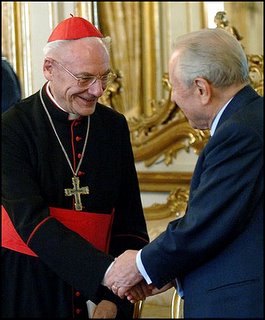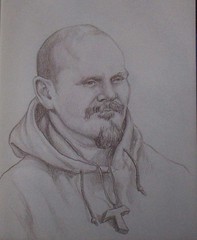Tuesday, November 15, 2005
Vatican cardinal says "Loose those stupid Jesus-Fish-eating-Darwin-Fish car thingies"
 While it may come as a shock to many Christians, scholars generally agree that the 4 Gospels contain 4 different versions of Jesus' public life. While their messages are similar (although addressed to different audiences and with different agendas), the chronological order of events, and even the places which events take place do not always agree. As soon as one begins to study the Bible closely, with even a small amount of open-mindedness, it becomes impossible to read it "literally" or see it in any way as an historical document. This is especially true for the "bookends" of the Bible--Genesis and The Revelation of St. John. Just as with the Gospels, a close reading of the first two chapters of Genesis reveal not one, but two distinct creation stories. The first is laid out for us in Genesis 1:1-2:3. This is the 6-day creation with one day off, the text which fundamentalists and creationists pound again and again in the fight against the Darwinian theory of evolution and even, as ridiculous as it may seem, the insistence that the earth is only 4,000 years old.
While it may come as a shock to many Christians, scholars generally agree that the 4 Gospels contain 4 different versions of Jesus' public life. While their messages are similar (although addressed to different audiences and with different agendas), the chronological order of events, and even the places which events take place do not always agree. As soon as one begins to study the Bible closely, with even a small amount of open-mindedness, it becomes impossible to read it "literally" or see it in any way as an historical document. This is especially true for the "bookends" of the Bible--Genesis and The Revelation of St. John. Just as with the Gospels, a close reading of the first two chapters of Genesis reveal not one, but two distinct creation stories. The first is laid out for us in Genesis 1:1-2:3. This is the 6-day creation with one day off, the text which fundamentalists and creationists pound again and again in the fight against the Darwinian theory of evolution and even, as ridiculous as it may seem, the insistence that the earth is only 4,000 years old.The other creation story is contained in Genesis 2:4-25. This story is more heavily focused on the creation of human beings and the relationship between men and women.
Here is the account of the creation of humans and animals in the first creation story:
"Then God made the beasts of the earth after their kind, and the cattle after their kind and everything that creeps upon the earth after its kind; and God saw that it was good.
"Then God said, Let us make man in our image, after our likeness; and let them have dominion over the fish of the sea, and over the fowl of the air, and over the cattle, and over all the wild beasts of the earth, and over every creeping thing that creeps upon the earth. So God created man in his own image, in the image of God he created them; male and female he created them." (Genesis 2:25-27 Lamsa Translation)
Here is the same account, but from the second story:
"And the Lord God formed Adam out of the soil of the earth, and breathed into his nostrils the breath of life; and man became a living being.
"And the Lord God planted a garden eastward in Eden; and there he put the man whom he had formed. And out of the ground the Lord God made to grow every tree that is pleasant to the sight and good for food; the tree of life also in the midst of the garden, and the tree of the knowledge of good and evil...
"Then the Lord God said, It is not good that man should be alone; I will make him a helper who is like him. And out of the ground the Lord God formed every beast of the field, and every fowl of the air; and brought them to Adam to see what he would call them; and whatever Adam called every living creature, that was its name. And Adam gave names to all cattle, and to all fowl of the air, and to all wild beasts; but for Adam there was not found a helper who was equal to him. So the Lord God caused a deep sleep to fall upon Adam, and he slept; and he took one of his ribs, and closed up the place with flesh and in its stead; And the rib which the Lord God had taken from Adam he made a woman, and brought her to Adam. And Adam said, This is now bone of my bones, and flesh of my flesh; she shall be called Woman, because she was taken out of Man." (Genesis 2:7-9, 18-23, Lamsa Translation).
Clearly, these are two distinctly different stories. First, and most glaring to me, is the fact that the order of creation is changed. In the first story, God creates animals first, and afterward creates man and woman at the same time. In the second story, man (the male) is created first, then God creates a bunch of animals in a futile attempt to find one which will be a suitable companion for Adam. Adam rejects one after another, till finally God sedates him, takes a rib from his side, and uses it as some sort of seed to create a woman.
Another, more subtle difference, which is a telltale sign for scholars that these two stories are not only different, but were written at very different times, is the change in names used to refer to God. In the first story, God is called simply "God". The Hebrew word used here is elohim. In the second story, the name becomes the Lord God. The Hebrew used here is adonai elohim. The difference is subtle, but important for those dating scriptures.
So, not only have we established that there are two disagreeing versions of the creation of mankind within the same chapter of Genesis, we have seen that these two versions were probably written at different times in human history, and (like the 4 Gospels) probably have different agendas and audiences. What am I getting at, you may ask? Am I saying the Bible is not a reliable document? Most definitly not. The Bible is one of the most reliable documents on earth, but not as an historical document, but as a spiritual document. These creation stories are myths, that is, they are meant to convey a spiritual Truth, not to be taken as historial fact. For me, the first creation myth paints God as the ultimate artist, and teaches that we should appreciate the world as His Art. Everything around us was painted on a blank canvas of black void, and we were placed in that work that we might appricate and enjoy it. The second myth, I feel, speaks of the creation of sexuality. In many Western Mystery traditions, the first human was either asexual or hermaphroditic (being either both male and female or neither male nor female). Then, some fundamental act separates the two, and Soul Mates are created. One becomes two, and the meaning of life is the reunion of the male and female aspects of our own soul--the healing of duality. I think this story of Adam's rib can easily be taken as a version of that myth; although there are many other interpretations, some less woman friendly than mine. It is not my place to say that my interpretation is better than those, only that it speaks more to the truth as I have experienced it.
The Vatican, it seems, agrees with my hypothesis that the book of Genesis is NOT an historical document, but a spiritual one. Earlier this month, in a press conference, Cardinal Paul Poupard spoke of the dangers of reading the Bible too literally and of rejecting the findings of Science. Read more for details:
----------------------------------------------------------------------------------------------
 Article copied from the Washington Post. Click Here for the original.
Article copied from the Washington Post. Click Here for the original.Vatican: Faithful Should Listen to Science
By NICOLE WINFIELD
The Associated Press
Friday, November 4, 2005; 10:12 AM
VATICAN CITY -- A Vatican cardinal said Thursday the faithful should listen to what secular modern science has to offer, warning that religion risks turning into "fundamentalism" if it ignores scientific reason.
Cardinal Paul Poupard, who heads the Pontifical Council for Culture, made the comments at a news conference on a Vatican project to help end the "mutual prejudice" between religion and science that has long bedeviled the Roman Catholic Church and is part of the evolution debate in the United States.
The Vatican project was inspired by Pope John Paul II's 1992 declaration that the church's 17th-century denunciation of Galileo was an error resulting from "tragic mutual incomprehension." Galileo was condemned for supporting Nicolaus Copernicus' discovery that the Earth revolved around the sun; church teaching at the time placed Earth at the center of the universe.
"The permanent lesson that the Galileo case represents pushes us to keep alive the dialogue between the various disciplines, and in particular between theology and the natural sciences, if we want to prevent similar episodes from repeating themselves in the future," Poupard said.
But he said science, too, should listen to religion.
"We know where scientific reason can end up by itself: the atomic bomb and the possibility of cloning human beings are fruit of a reason that wants to free itself from every ethical or religious link," he said.
"But we also know the dangers of a religion that severs its links with reason and becomes prey to fundamentalism," he said.
"The faithful have the obligation to listen to that which secular modern science has to offer, just as we ask that knowledge of the faith be taken in consideration as an expert voice in humanity."
Poupard and others at the news conference were asked about the religion-science debate raging in the United States over evolution and "intelligent design."
Intelligent design's supporters argue that natural selection, an element of evolutionary theory, cannot fully explain the origin of life or the emergence of highly complex life forms.
Monsignor Gianfranco Basti, director of the Vatican project STOQ, or Science, Theology and Ontological Quest, reaffirmed John Paul's 1996 statement that evolution was "more than just a hypothesis."
"A hypothesis asks whether something is true or false," he said. "(Evolution) is more than a hypothesis because there is proof."
He was asked about comments made in July by Austrian Cardinal Christoph Schoenborn, who dismissed in a New York Times article the 1996 statement by John Paul as "rather vague and unimportant" and seemed to back intelligent design.
Basti concurred that John Paul's 1996 letter "is not a very clear expression from a definition point of view," but he said evolution was assuming ever more authority as scientific proof develops.
Poupard, for his part, stressed that what was important was that "the universe wasn't made by itself, but has a creator." But he added, "It's important for the faithful to know how science views things to understand better."
The Vatican project STOQ has organized academic courses and conferences on the relationship between science and religion and is hosting its first international conference on "the infinity in science, philosophy and theology," next week.

